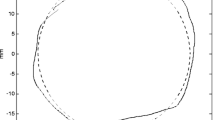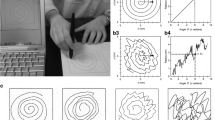Abstract
In a spiral task, the accuracy of the spiral trajectory, which is affected by tracing or tracking ability, differs between patients with Parkinson’s disease (PD) and essential tremor (ET). However, not many studies have analyzed velocity differences between the groups during this task. This study aimed to examine differences between the groups related to this characteristic using a tablet. Fourteen PD, 12 ET, and 12 control group participants performed two tasks: tracing a given spiral (T1) and following a guiding point (T2). A digitized tablet was used to record movements and trajectory. Effects of direct visual feedback on intergroup and intragroup velocity were measured. Although PD patients had a significantly lower T1 velocity than the control group (p < 0.05), they could match the velocity of the guiding point (3.0 cm/s) in T2. There was no significant difference in the average T1 velocity between ET and the control groups (p = 0.26); however, the T2 velocity of ET patients was significantly higher than the control group (p < 0.05). They were also unable to adjust the velocity to match the guiding point, indicating that ET patients have a poorer ability to follow dynamic guidance. When both groups of patients have similar action tremor severity, their ability to follow dynamic guidance was still significantly different. Our study combined visual feedback with spiral drawing and demonstrated differences in the following-velocity distribution in PD and ET. This method may be used to distinguish the tremor presentation of both diseases, and thus, provide accurate diagnosis.




Similar content being viewed by others
References
Jain S, Lo SE, Louis ED (2006) Common misdiagnosis of a common neurological disorder: how are we misdiagnosing essential tremor? Arch Neurol 63:1100–1104
Thenganatt MA, Jankovic J (2016) The relationship between essential tremor and Parkinson’s disease. Parkinsonism Relat Disord 22:S162–S1S5
Algarni M, Fasano A (2018) The overlap between Essential tremor and Parkinson disease. Parkinsonism Relat Disord 46:S101–S1S4
Chen K-H, Lin P-C, Chen Y-J, Yang B-S, Lin C-H (2016) Development of method for quantifying essential tremor using a small optical device. J Neurosci Methods 266:78–83
Sisti JA, Christophe B, Seville AR, Garton AL, Gupta VP, Bandin AJ, Yu O, Pullman SL (2017) Computerized spiral analysis using the iPad. J Neurosci Methods 275:50–54
Sharma S, Pandey S (2016) Approach to a tremor patient. Ann Indian Acad Neurol 19:433
Yu N-Y, Van Gemmert AW, Chang S-H (2017) Characterization of graphomotor functions in individuals with Parkinson’s disease and essential tremor. Behav Res Methods 49:913–922
Wei C, Xiao Z (2016) Review on clinical update of essential tremor. Neurol Sci 37(4):495–502
Liu X, Miall RC, Aziz TZ, Palace JA, Haggard PN, Stein JF (1997) Analysis of action tremor and impaired control of movement velocity in multiple sclerosis during visually guided wrist-tracking tasks. Mov Disord 12:992–999
Liu X, Tubbesing SA, Aziz TZ, Miall RC, Stein JF (1999) Effects of visual feedback on manual tracking and action tremor in Parkinson’s disease. Exp Brain Res 129:477–481
Schwartz M, Groshar D, Inzelberg R, Hocherman S (2004) Dopamine-transporter imaging and visuo-motor testing in essential tremor, practical possibilities for detection of early stage Parkinson’s disease. Parkinsonism Relat Disord 10:385–389
Schwartz M, Badarny S, Gofman S, Hocherman S (1999) Visuomotor performance in patients with essential tremor. Mov Disord 14:988–993
Hocherman S, Giladi N (1998) Visuornotor control abnormalities in patients with unilateral parkinsonism. Neurology 50:1648–1654
Lin P-C, Chen K-H, Yang B-S, Chen Y-J (2018) A digital assessment system for evaluating kinetic tremor in essential tremor and Parkinson’s disease. BMC Neurol 18:25
Deuschl G, Bain P, Brin M (1998) Consensus statement of the movement disorder society on tremor. Mov Disord 13:2–23
Daniel S, Lees A (1993) Parkinson’s Disease Society Brain Bank, London: overview and research. J Transm Suppl 39:165–172
Inzelberg R, Schechtman E, Hocherman S (2008) Visuo-motor coordination deficits and motor impairments in Parkinson’s disease. PLoS One 3:e3663
Kulkarni O, Lafaver K, Tarsy D (2013) The “floating door sign” in Parkinson’s disease. Parkinsonism Relat Disord 19:825–826
Chen J, Ho S-L, Lee TM-C, Chang RS-K, Pang SY-Y, Li L (2016) Visuomotor control in patients with Parkinson’s disease. Neuropsychologia 80:102–114
Rao AK, Gillman A, Louis ED (2011) Quantitative gait analysis in essential tremor reveals impairments that are maintained into advanced age. Gait Posture 34:65–70
Farkas Z, Szirmai I, Kamondi A (2006) Impaired rhythm generation in essential tremor. Mov Disord 21:1196–1199
Bareš M, Lungu OV, Husárová I, Gescheidt T (2010) Predictive motor timing performance dissociates between early diseases of the cerebellum and Parkinson’s disease. Cerebellum 9:124–135
Coltz J, Johnson M, Ebner T (1999) Cerebellar Purkinje cell simple spike discharge encodes movement velocity in primates during visuomotor arm tracking. J Neurosci 19:1782–1803
Lehéricy S, Benali H, Van de Moortele P-F, Pélégrini-Issac M, Waechter T, Ugurbil K, Doyon J (2005) Distinct basal ganglia territories are engaged in early and advanced motor sequence learning. Proc Natl Acad Sci U S A 102:12566–12571
Funding
This work was supported by the collaborative project between National Chiao Tung University and National Taiwan University Hospital Hsinchu Branch (grant numbers 104W970 and 105W970), and Taiwan Ministry of Science and Technology (grant number MOST 105-2628-E-009-003-MY3).
Author information
Authors and Affiliations
Corresponding author
Ethics declarations
Conflict of interest
The authors declare that they have no conflict of interest.
Ethical approval
All procedures performed in studies involving human participants were in accordance with the ethical standards of the institutional and/or national research committee and with the 1964 Helsinki declaration and its later amendments or comparable ethical standards.
Rights and permissions
About this article
Cite this article
Chen, KH., Lin, PC., Yang, BS. et al. The difference in visuomotor feedback velocity control during spiral drawing between Parkinson’s disease and essential tremor. Neurol Sci 39, 1057–1063 (2018). https://doi.org/10.1007/s10072-018-3331-4
Received:
Accepted:
Published:
Issue Date:
DOI: https://doi.org/10.1007/s10072-018-3331-4




